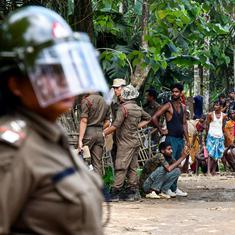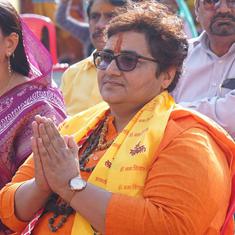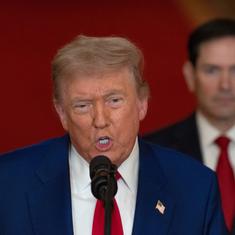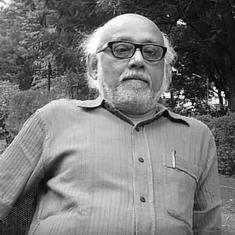It would not be an exaggeration to say that BR Ambedkar is the most popular historical figure in Indian politics today. Every party claims his legacy and the Marathi politician is referenced in speeches, election campaigns and debates. On Saturday, Narendra Modi claimed that he, coming from a “backward section of society”, was prime minister today only because of Ambedkar. Modi was speaking on the occasion of Ambedkar’s 127th birth anniversary. A day earlier, the prime minister had inaugurated a national memorial for Ambedkar.
Yet, things were not always so. Till the 1980s, Ambedkar was fairly unknown outside a small circle of Dalit ideologues. Neither the mainstream Left, Centre nor Right had much space for Ambedkar in their histories. This changed with Dalit political assertion. The rise of Kanshi Ram and the Bahujan Samaj Party, which he founded in 1984, fashioned Dalit identity into a voting bloc, forcing national parties to stop taking Scheduled Caste voters for granted, and instead woo them explicitly. In this scramble, the iconography of Ambedkar was seen as extremely useful.
Ambedkar’s radical politics
The ideas that Ambedkar brought to the table were far outside the mainstream of Indian politics in the 1920s, the decade he entered public life. This, of course, led to his long battle with Mohandas Gandhi, then India’s most powerful politician, and other members of the Congress – a body Ambedkar saw as being controlled by upper caste interests.
In 1955, after nearly half a century in politics, Ambedkar would speak to the British Broadcasting Corporation, arguing that Gandhi was no “Mahatma” (Sanskrit for “great soul”), “not even from the point of view of his morality”.
Gandhi and Ambedkar would clash over many issues, but perhaps the most well-known confrontation was Ambedkar’s strident support for separate electorates. Ambedkar believed that like the Muslims of British India, Dalits needed this device to protect their rights. In Ambedkar’s system of separate electorates, Dalit voters would vote only for Dalit candidates, who would go on to become legislators in the Central and provincial assemblies of British India. It took the threat of a fast-unto-death by Gandhi in 1932 to force Ambedkar to climb down from this demand.
If Ambedkar did not like Gandhi and accused him of furthering upper caste interests, the antipathy was mutual. In 1946, Gandhi wrote to Vallabhbhai Patel, complaining about Ambedkar’s frequent threats to convert:
“The main problem is about Ambedkar. I see a risk in coming to any sort of understanding with him, for he has told me in so many words that for him there is no distinction between truth or untruth or between violence and non-violence. He follows one single principle, viz. to adopt any means which will serve his purpose. One has to be very careful indeed when dealing with a man who would become a Christian, a Muslim or Sikh and then be reconverted according to his convenience. There is much more I could write in the same strain”
Right wing antipathy
If Ambedkar angered Gandhi, his politics of Dalit identity, which often ran counter to that of Hindu identity, antagonised the right wing too. In 1932, the Hindu Mahasabha’s BS Moonje signed a pact with MC Rajah, the Dalit leader from Madras presidency, to give up separate electorates. Ambedkar’s politics greatly angered the strongest right-wing leader within the Congress too, Vallabhbhai Patel. In 1946, Patel made sure that Ambedkar was not elected to the Constituent Assembly from Bombay province – the Congress controlled enough numbers in the provincial Assembly to make sure this happened. Instead, Ambedkar had to seek election from Bengal, where the Muslim League supported his candidature. In the Constituent Assembly, Patel bitterly attacked Ambedkar for trying to push a weak form of separate electorates into the Constitution, accusing him of trying to “partition the country”:
“To the Scheduled Caste friends, I also appeal: Let us forget what Dr Ambedkar has done. Let us forget what you [Nagappa, another Dalit Assembly member and an Ambedkarite] did. You have very nearly escaped partition of the country again on your lines. You have seen the result of separate electorates in Bombay, that when the greatest benefactor of your community [referring to Gandhi] came to Bombay to stay in bhangi quarters it was your people who tried to stone his quarters. What was it? It was again the result of this poison, and therefore I resist this only because I feel that the vast majority of the Hindu population wish you well. Without them where will you be? Therefore, secure their confidence and forget that you are a Scheduled Caste.”
Patel’s outburst and the fact that he made sure Ambedkar’s proposal was crushed, point to the fact that while Ambedkar was made chairman of the drafting committee of the Constitution by the Congress, this did not mean he would be allowed a free hand in the position to push his own policies.
Nehru and Ambedkar
Ambedkar did not have much luck with the centre-left Jawaharlal Nehru either. In his resignation letter from the council of ministers in 1951, Ambedkar attacked Prime Minister Nehru for ignoring him. While he had served as law minister, Ambedkar claimed that the ministry was only a “soapbox” and he had desired some “administrative portfolio”. In return, Nehru had promised the Planning Department, claimed Ambedkar – a promise Nehru never fulfilled. “Many Ministers have been given two or three portfolios so that they have been overburdened. Others like me have been wanting more work,” complained Ambedkar.
If Ambedkar did not get along well with Nehru, his time as law minister saw him anger the Right even more for his promotion of the Hindu Code Bills, which sought to modernise significant sections of traditional Hindu law, outlawing polygamy, introducing the concept of divorce and giving women property rights.
In 1956, when Ambedkar died, Nehru released a brief condolence message which described him as a “very controversial figure in Indian politics”. Ambedkar’s biographer Dhananjay Keer was even more blunt. Given his opposition to Gandhi, Keer wrote that Ambedkar had become the “most hated man in India”:
“He was stigmatised as an uncivil, insolent, inordinately rude man, devoid of human consideration. He was represented as a devil, was cursed as a public nuisance number one and was dammed as a reactionary, a stooge of the British government, a traitor to the country and a destroyer of Hinduism.”
Ambedkar’s marginalisation from the mainstream continued for decades after his death. Kancha Ilaiah, academic and thinker on caste, says:
“Until 1990, Ambedkar was untouchable to all mainstream political parties. The question of the BJP looking at him did not arise at that time. The implementation of the Mandal Commission report, the VP Singh government honouring Ambedkar with the Bharat Ratna and the massive Dalit civil societal celebration of his role across the country triggered a new debate. From 1991 to 2015, emerging civil societal forces acquired definite intellectual status in universities and colleges and became a force to reckon with.”
The rise of the Bahujan Samaj Party
What was it that changed in the 1990s? In 1978, an Ambedkarite organisation called the All India Backward and Minority Communities Employees Federation was formed. Kanshi Ram was one of its founders. Known as BAMCEF, the body allowed for large numbers of Dalit public sector employees and civil servants to mobilise. This later led to the establishment of the Bahujan Samaj Party, formed with the aim of consolidating Dalits and other backward castes into a voting bloc. The Bahujan Samaj Party changed politics in Uttar Pradesh – India’s largest state and a lodestar of national politics – with its leader, Mayawati becoming chief minister on four occasions.
Mainstream, upper caste dominated politics had long ignored Dalits, treating them only as an inexhaustible, uncomplaining supply of votes during elections. The Bahujan Samaj Party changed that. Now Dalits would have to be wooed on their own terms. This is where the iconography of Ambedkar comes in. Ambedkar was core to the Bahujan Samaj Party and the ideology of its founder. However, Ambedkar was now taken up by upper caste politicians as a way to woo Dalit voters.
In 2018, as a wave of Dalit protests rock the country, the BJP’s invocation of Ambedkar has become even more urgent. During his lifetime, Ambedkar saw little political success, with the parties floated by him losing to mainstream parties in elections. Ironically, now it seems mainstream politics in India can barely get by without using Ambedkar’s name.










